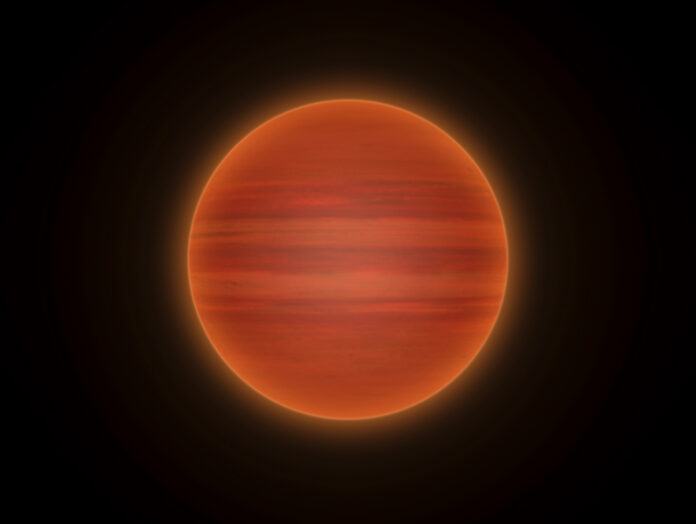As of today, more than 5600 exoplanets, planets that are gravitationally bound to stars other than our sun, have been discovered. Within that catalog exists a vast array of planetary classes – small rocky worlds like our own, ocean worlds completely covered in liquid water, and gas giants that dwarf even Jupiter, among many others.
Planets come in a range of sizes and compositions and are differentiated from stars primarily due to their inability to sustain nuclear fusion in their cores. So how big does a planet have to get before it becomes a star? And what are the characteristics of objects that straddle this gray area between planets and stars?
“This mass limit is considered to be about 75 to 80 Jupiter masses. This is basically the minimum mass to sustain hydrogen fusion. Below this mass, the gravitational force inwards is insufficient to generate the temperature needed for core fusion of hydrogen and the ‘failed’ star instead forms a brown dwarf,” says Basmah Riaz, a Loyola Marymount University astrophysicist who studies objects called brown dwarfs.
What are Brown Dwarf Stars?
Brown dwarfs are cosmic objects that blur the distinct boundaries between planets and stars. They typically form under similar conditions that stars like our sun do – through a collapsing cloud of interstellar gas and dust.
However, brown dwarfs are too low-mass to sustain the temperatures and pressures required to induce a hydrogen thermonuclear fusion reaction. In other words, their low-mass, relative to other stellar objects, means gravity can’t squeeze the core of the star enough to generate the conditions needed for hydrogen fusion.
But unlike large gas giant planets like Jupiter, brown dwarfs are massive enough to induce the fusion of deuterium, which is an isotope of hydrogen (deuterium is made of one proton, one neutron, and one electron, while hydrogen is just one proton and one electron). Through the fusion of deuterium, brown dwarfs emit some light and heat, and would appear different colors to the naked eye depending on their temperature (warmer would be closer to orange/red, while cooler would be magenta/black).
“Brown dwarfs are born with primordial deuterium, which is a heavy isotope of hydrogen. They shine like stars until they undergo deuterium fusion and then just fade away with time. So, nuclear fusion in brown dwarfs ends when all of the deuterium has been burned,” says Riaz.
As Riaz mentions, once the fusion of deuterium inside the brown dwarf slows as it runs out of fuel, the object begins to slowly dim.
Read More: Citizen Scientists Are Using the JWST to Study Mysterious Brown Dwarfs
The Mass of Brown Dwarfs
Brown dwarfs themselves can vary greatly in mass, which also impinges on what they can fuse to generate energy. At the high-mass end of the spectrum, somewhere between 65 to 90 times that is as massive as Jupiter, some brown dwarfs are capable of fusing lithium, the third element on the periodic table.
On the other hand, some low mass brown dwarfs might undergo no fusion at all, and for those that do, they may burn through all of their fuel in only 10 million years (a small amount of time on cosmic timescales, as our sun is over 4 billion years old).
Read More: How Do Stars Produce and Release Energy?
Hosting Planetary Systems
Because brown dwarfs form similarly to other stars, they are also capable of having their own planetary systems.
“Since brown dwarfs host protoplanetary disks that are the formation sites of planets, brown dwarfs could also potentially host a planetary system. Also, the disks around brown dwarfs dissipate over a longer timescale than Sun-like stars, so it may take longer to form a planetary system around a brown dwarf,” adds Riaz.
While some brown dwarfs may form stable planetary systems in their own right, astronomers have observed rogue brown dwarfs – objects that are free floating in space. A typical rogue world, usually a planet, gets ejected from its planetary system during the early stages of planetary formation when the system is more gravitationally chaotic.
However, in the case of rogue brown dwarfs, it’s possible that these objects are sent on haphazard voyages through space by gravitationally interacting with other nearby stars.
Unfortunately for us, nature doesn’t produce things in neat categories. When it comes to all cosmic objects, the boundaries can get blurry, and brown dwarfs occupy this strange place between star and planet. For now, though, astronomers will continue to comb the sky for their presence. Who knows, we may even find suitable conditions for life around one of them.
Read More: Stars Invisible to the Eye Could Host Watery Exoplanets
Article Sources
Our writers at Discovermagazine.com use peer-reviewed studies and high-quality sources for our articles, and our editors review for scientific accuracy and editorial standards. Review the sources used below for this article:
Conor Feehly is a New Zealand-based science writer who covers a wide range of topics, including astronomy and neuroscience, with an eye for research at the intersection of science and philosophy. He received a master’s in science communication degree from the University of Otago. Conor is a regular contributor to Discover Magazine, with his work also appearing in New Scientist, Nautilus Magazine, Live Science, and New Humanist among others.
Source : Discovermagazine






